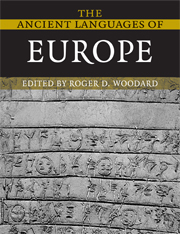Book contents
- Frontmatter
- Contents
- List of figures
- List of tables
- List of maps
- List of contributors
- Notes on numbering and cross-referencing
- List of abbreviations
- Preface
- Preface to the first edition
- 1 Language in ancient Europe: an introduction
- 2 Attic Greek
- 3 Greek dialects
- 4 Latin
- 5 Sabellian languages
- 6 Venetic
- 7 Etruscan
- 8 Continental Celtic
- 9 Gothic
- 10 Ancient Nordic
- Appendix 1 Indo-European
- Appendix 2 Full tables of contents from The Cambridge Encyclopedia of the World's Ancient Languages, and from the other volumes in the paperback series
- Index of general subjects
- Index of grammar and linguistics
- Index of languages
- Index of named linguistic laws and principles
1 - Language in ancient Europe: an introduction
Published online by Cambridge University Press: 01 September 2010
- Frontmatter
- Contents
- List of figures
- List of tables
- List of maps
- List of contributors
- Notes on numbering and cross-referencing
- List of abbreviations
- Preface
- Preface to the first edition
- 1 Language in ancient Europe: an introduction
- 2 Attic Greek
- 3 Greek dialects
- 4 Latin
- 5 Sabellian languages
- 6 Venetic
- 7 Etruscan
- 8 Continental Celtic
- 9 Gothic
- 10 Ancient Nordic
- Appendix 1 Indo-European
- Appendix 2 Full tables of contents from The Cambridge Encyclopedia of the World's Ancient Languages, and from the other volumes in the paperback series
- Index of general subjects
- Index of grammar and linguistics
- Index of languages
- Index of named linguistic laws and principles
Summary
The Sanscrit language, whatever be its antiquity, is of a wonderful structure; more perfect than the Greek, more copious than the Latin, and more exquisitely refined than either, yet bearing to both of them a stronger affinity, both in the roots of verbs and in the forms of grammar, than could possibly have been produced by accident; so strong, indeed, that no philologer could examine them all three, without believing them to have sprung from some common source, which, perhaps, no longer exists: there is a similar reason, though not quite so forcible, for supposing that both the Gothik and the Celtick, though blended with a very different idiom, had the same origin with the Sanscrit; and the old Persian might be added to the same family.
Asiatick Researches 1:442–443In recent years, these words of an English jurist, Sir William Jones, have been frequently quoted (at times in truncated form) in works dealing with Indo-European linguistic origins. And appropriately so. They are words of historic proportion, spoken in Calcutta, 2 February 1786, at a meeting of the Asiatick Society, an organization that Jones had founded soon after his arrival in India in 1783 (on Jones, see, inter alia, Edgerton 1967).
- Type
- Chapter
- Information
- The Ancient Languages of Europe , pp. 1 - 13Publisher: Cambridge University PressPrint publication year: 2008



